The Land Of China -- Explore by Province
Inner Mongolia (Nei Mongol)
 a Herd of Wild Horses
a Herd of Wild Horses
|
Inner Mongolia (Nei Mongol) is the the first national autonomous region established in China. It stretches along China's northern borber with Mongolia and Russia and covers an oblong area of over 1.28 million square kilometers, one eighth of China. Of all the Chinese provinces and autonomous regions, Inner Mongolia is the third largest after Xinjiang and Tibet.
The Mongols united under Genghis Khan in 1206, and their descendents went on to conquer the rest of China and then parts of Europe in the 13th and 14th centuries. Today, this region is only for strong and adventurous tourists who don't mind a mutton diet.
Inner Mongolia has a temperate continental monsoonal climate with four distinct seasons because of it is great distance from sea and its high terrain and mountains. It has long, cold winters and short, warm summers. The nights are cool, and the winters are very cold. Known as the "Arctic in China," the record low temperature is 50° C. It is windy in all seasons, especially in spring when sandstorms are prominent.
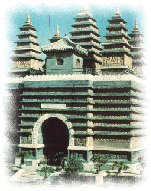 an Inner Mongolian Temple
an Inner Mongolian Temple
|
Inner Mongolia's capital city, Hohhot (Green City), is 1000 meters above sea level. It dates all the way back to the Ming Dynasty, at least some 400 years ago. The traditional religion is Lamaism, a branch of Buddhism related to that of Tibet. Dazhao Temple, the oldest temple, has a rare silver Buddha and many musical instruments. Tourists can travel out and sleep in a yurt in the grasslands, ride camels and camel carts, or try Mongolian bows and arrows. They can also drink tea laced with milk, butter, and grain or eat barbecued lamb, mutton hot pot, beef kabab, and camel hoof, which allows tourists to get an impression of Mongolian lifestyle. This deepens after a visit to the Provincial Museum. Mongolian folk songs and dances are distinct, while saber-fighting, horseback acrobatics, and horse racing still reflect the nomadic life of Mongols. Inner Mongolia produces woolen textiles, carpets, tapestries and Mongolian-style riding boots, sabers, saddles. stirrups and felt stockings.
 Xilamuren Steppe
Xilamuren Steppe
|
Among the first few Inner Mongolia steppes catering to tourism, Xilamuren, 87 km to the north of Hohhot and 1,700 metres above sea level, is a summer resort where the air is fresh with lush green grass and a midsummer night as cool as if it was autumn. The Yurt-hotels are completed with all the necessary modern facilities. Tourist activities include horse and camel riding, visits to herdspeople's homes, watching Mongolian singing and dancing performances, wrestling competitions, horse & camel racing and joining campfire parties. Authentic Mongolian food are also a wonderful treat with milk tea, braised mutton chunks, instant-boiled lamb, kebab, and roast mutton legs, mutton chops and a whole roast lamb.
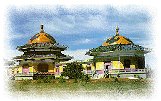 the Mausoleum of Genghis Khan
the Mausoleum of Genghis Khan
|
Emperor Taizu (1162-1227) of Yuan Dynasty (1271-1386) was entombed in Gandch steppe, yijinhuolo Banner in the southwestern part of Inner Mongolia. The 5.5-hectare mausoleum consists mainly of a row of three yurt shaped palaces with domes of glazed yellow tiles bordered with blue and white walls together with vermilion gates.
Leading to the gate of each building is a flight of eighty-one steps, flanked by pines and halls to match the central one. In the southern corner of the compound stands a palace in which the Khan used to stay when he was away from his capital.
 the Noisy Sand Bay
the Noisy Sand Bay
|
The Noisy Sand Bay or Xiangshawan is situated in the middle section of the Kubuq'i Desert and Dalate Banner, 1,150 metres above sea level. It is actually a small sand slope measuring 60 by 40 meters at an angle of about 45 degrees. On a sunny day, when a person slides down the slope from the top, hands stirring the sand on the way down, the sand drums like a plane flying overhead. Five km to the northwest of the Noisy Sand Bay is a stretch of dense forest where yurt-hotels accomodate tourists
 the Wudang Lamasery
the Wudang Lamasery
|
The Wudang Lamasery was built during the latter half of the 17th century 70 km to the south of Baotou City. It is the largest and best-preserved of its kind in Inner Mongolia and contains six temple hars, three mansions for Living Buddhas, and an altar hall covering a total area of 20 hectares! Constructed on mountain slopes, terrace above terrace, the magnificent lamasery overlooks the clusters of small lamaseries at the foot of the mountain and attracts many visitors each year
Inner Mongolia is a multi-national autonomous region. It had a population of 21 million by the end Up to 1982,the Mongolian nationalitynumbered 2.4 million,In addtion,there are other ethnic minority groups--the Huis,the Manchus,the Daurs,the Ewenkis the Koreans,the Oroqens,the Zhuangs,the Tibetans and the Tus.
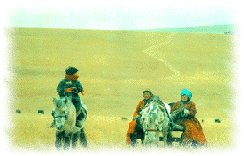



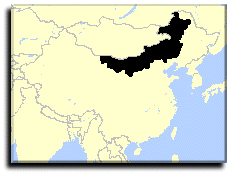
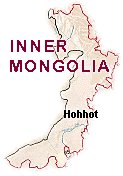










 Chinese Culture
Chinese Culture